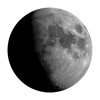γ Trianguli Australis (gamma Trianguli Australis)
γ Trianguli Australis is a variable main-sequence star of spectral class A1 in the constellation of Triangulum Australe.
γ Trianguli Australis visual magnitude is 2.89. Because of its brightness, γ Trianguli Australis is clearly visible to the naked eye when observed from locations with dark skies, and should be also quite easily visible from light polluted areas.

Celestial Coordinates
Apparent
J2000
Galactic Coordinates
Finder Chart

Magnitude, Color, Spectral Class
The red dot in the diagram below shows where γ Trianguli Australis is situated in the Hertzsprung–Russell diagram.

Distance, Radial Speed, Proper Motion
γ Trianguli Australis is distant 182.63 light years from the Sun and it is moving towards the Sun at the speed of 3 kilometers per second.
Alternative Designations
Visibility from Your Location
γ Trianguli Australis (gamma Trianguli Australis) is currently not visible from Pianling, China









